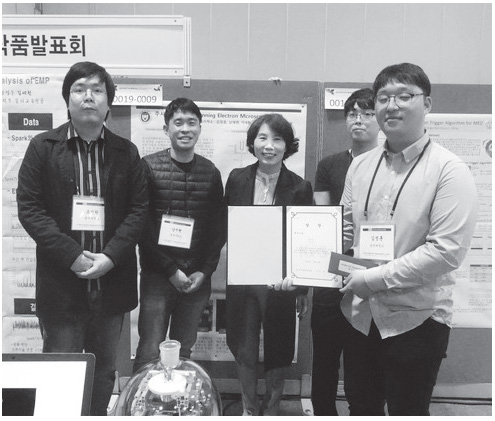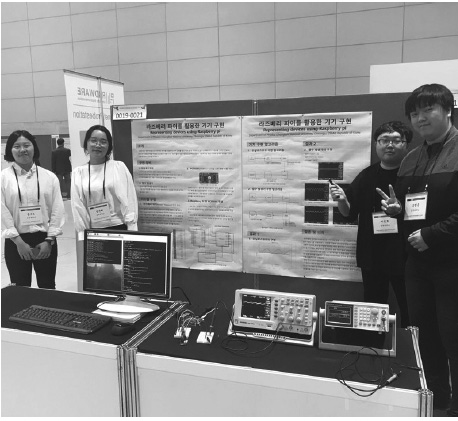The two clubs of the Department of Physics, SEM and RPG, took part in the 2019 KPS (Korean Physical Society) Fall Undergraduate Research Poster Session. The Undergraduate Research Poster Session was held for undergraduate students who are interested in physics and want to present their research under the guidance of one of their professors. Students in majors related to physics were also able to participate. This year, one team from CBNU, SEM (lead professor: Kang Byeong-won), which made a scanning electron microscope, won the grand prize. CBT interviewed the two teams. -Ed.
<Scanning Electron Microscope (SEM) Team>
1. Can you introduce your team?
Lee Se-hwan (’16)-Our team is working on making a scanning electron microscope (SEM). We used materials supported by the university to make a basic electron microscope. The microscope is not at a professional level, but we used the knowledge we learned in class to make it. Up to now, I have been the team president, and there are three other members: Kim Jung-hun, Cho Jin-wan, and Nam Ja-hyeon.
2. How did the team get to participate in the Undergraduate Research Poster Session?
Lee Se-hwan (’16)-It seemed that the progress of making a SEM at school was moving slowly. Then one day, our professor asked us if we would like to participate in the KPS Undergraduate Research Poster Session. Our team thought that it would be a good chance to get feedback and advice by participating in it. Unexpectedly, many people liked our project and we won an award, but we think we still have a long way to go.
3. Please introduce the team’s project.
Kim Jung-hun (’16)-We made the scanning electron microscope (SEM). The SEM uses electrons to look at a sample in detail, which differentiates it from a common microscope. To make electrons arrive at the sample, a vacuum is essential, so what we did first was to make a vacuum system. With a magnetic field lens, we focused the electrons on the sample. Next, by using the electron gun, we made it possible for the electrons to irradiate the sample.
4. How did taking part in the Undergraduate Research Poster Session feel?
Cho Jin-wan (’16)-At first, a research device like a SEM was just a difficult and complicated gadget to me. However, after trying to make one, I realized that undergraduates also have the ability to manufacture such devices. When our team faced problems, we worked together to solve them, and the joy of overcoming it was tremendous. Our team still has a long way to go, but working on a SEM was enjoyable, and our teamwork improved as well as our understanding of the theories of SEM. I want to recommend that our junior colleagues should participate in the session next year. It was really fun.
5. What is your team’s plan or goal?
Cho Jin-wan (’16)-We haven’t finished making the microscope, so our first goal is to complete it. Using the completed microscope, we will see the images that the microscope shows us. The second goal is to increase the magnification of our completed microscope. If we are able to see an image, we will give help to our juniors, who will later take part in an electron microscope competition.
<Raspberry Pi Group>
1. Can you introduce your team?
Lee Jung-ho (’17)- Our group used a low cost, credit-card sized computer called Raspberry Pi to control different kinds of devices and create advanced equipment. Our team name is RPG (Raspberry Pi Group), literally meaning a group that handles a Raspberry Pi. Until now, our group’s president has been Cho Young-jun, and there are five other members: Shin Ji-ho, Jo Je-reung, Eom Seon-hye, Youn Su-o and myself.
2. How did the team get to participate in the Undergraduate Research Poster Session?
Cho Yong-jun (’16)-Personally I wanted to do something special and meaningful before graduating from university. The Undergraduate Research Poster Session was an event where I could prepare and show people what our team had researched. Eom Seon-hye (’16)- It isn’t easy for juniors in university to participate in the KPS. With such a rare opportunity for me, I wanted to see the physics trends and the research of the many professors.
3. Please introduce the team’s project.
Lee Jung-ho (’17)- Our team used a Raspberry Pi to make a function generator and an oscilloscope. We showed that, with this small computer, we could make a device. Eom Seon-hye (’16)- An actual device is big and pricey, but what we made is the size of our hand. It’s portable and cheap, and it can act as both a function generator and an oscilloscope. Our project has the advantage that even children are able to handle it.
4. How did taking part in the Undergraduate Research Poster Session feel?
Cho Young-jun (’16)- I was really nervous at first, as I was concerned about the people at the KPS not liking our project. What was kind of a letdown was that our booth didn’t get as much interest as the other booths did. Anyway, it was a good experience, and our team luckily had time to see some lectures by the many professors.
5. What is the your team’s plan or goal?
Cho Young-jun(’16)- Our short-term goal is to participate in next year’s Undergraduate Research Poster Session. By using the device we made this year, our next project will be to make a hygrometer. We are at a step of planning what kind of hygrometer to make. Our long-term goal is to become a club in which students start a project because it looks interesting and fun, not because of an obligation.
6. Is there anything you want to say to CBNU students?
Eom Seon-hye (’16)- In the fall KPS, people saw our team’s project as a project that students in the College of Engineering might do. Convergence between subjects is now essential, and sooner or later there will be fewer distinctions between the research future researchers will do. I want students to study not only their major but also different majors. I also want them to know that, as we are now in the fourth industrial revolution, physics has the advantage of converging various fields.
<Lead Professor's Interview>
Kang Beong-won (The lead professor of SEM)
Through our club activities, students are able to understand better what they’ve learned in class and how to apply it. Students who have these experiences are more competitive than other graduates in physics when looking for a job. Also, when entering graduate school, it is possible for them to complete a degree program in a shorter time after acquiring the knowledge and experience of making an experimental device. By continuing the club activity, I am capable of creating competitive talents in physics and advanced science equipment.
At the 2019 Fall KPS Undergraduate Research Poster Session, about 30 different works were exhibited. Unfortunately, there were many projects that were on the level of undergraduate students’ graduation work. Compared to those projects, our SEM’s results were not only creative but also very difficult to present as an undergraduate project, and the project took several months. These are the reasons why I think our team received a high evaluation.
To CBNU students, you have more potential than you think you have. As a professor at CBNU, I want to give students the opportunity to find their ability and use it. What I want is for students to utilize various opportunities and develop themselves further.
Kim Kyoung-Ho (The lead professor of RPG)
The future industrial society will require users to develop their own software and advance it. Students majoring in physics mainly solve problems based on mathematics. As a result, their understanding of computers can be poor. I am hopeful that the activities of our club RPG will help our students to understand computers better. Also, by undertaking applied projects, I hope students will be able to experience the convergence of hardware and software. Our club is new, so there is no distinct direction of how the club will move forward. Beyond the use and understanding of small computers, we are planning to create works based on real projects. We are hoping to use a Raspberry Pi to develop a physics education kit.
At the 2019 Fall KPS, the Undergraduate Research Poster Session was held, and it gave many undergraduates an opportunity to participate in it. I hope that this opportunity to present the undergraduates’ projects will continue in an effort to enhance the students’ interest in physics.
By Youn Su-o | sy40@cbnu.ac.kr
By Kim Min-ji | mj39@cbnu.ac.kr


 All
All Campus News
Campus News






 Youn Su-o&Kim Min-ji
Youn Su-o&Kim Min-ji











